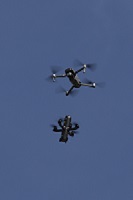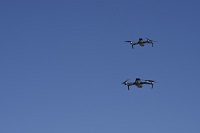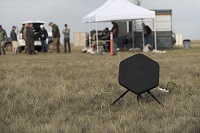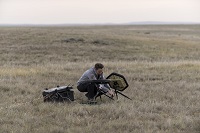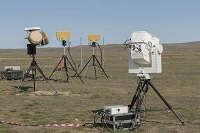Counter Unmanned Aerial Systems Sandbox 2019
Suffield, Alberta
12 Sep - 7 Oct 2019
- 12 Companies
- 298 Red Team attacks flown
- 33 Technical and CAF end-user experts
- 28 Organizations receiving the results
How might we detect and/or defeat (kinetically or non-kinetically) Micro and Mini Unmanned Aerial Systems (UAS)?
“That was the best counter-drone event by far!!! It helps us speed up our product development time and understanding with real combat scenarios.”
- AerialX, Noam Kenig, Founder and CEO
“The Canadian Army is thrilled to see advancement happening in the field of Counter Unmanned Aerial Systems […]”
- Colonel Chris Renahan, Directorate Land Requirement Canadian Army
“The sandbox was the best-run military test or exercise event I've ever participated in.”
- DroneShield, John Franklin, Founder
Sandbox Overview
Sandbox Overview
In September 2019, the IDEaS program set up camp in Suffield, Alberta, over a four week period to host its very first Sandbox. For this first iteration, 12 teams of innovators from six different countries were given the opportunity to test and demonstrate their medium to high Solution Readiness Level technologies and approaches in the realm of Counter Unmanned Aerial Systems (CUAS), receiving feedback from experts and end-users.
Defence and Security partners were represented by the Canadian Army, Canadian Special Operations Forces Command (CANSOFCOM), Royal Canadian Mounted Police (RCMP), Transport Canada, and Defence Research and Development Canada (DRDC) technology experts, among others. An industry partner, Qinetiq Target Systems, was also brought in to assist the IDEaS Red Team whose purpose was flying adversarial drones against the CUAS systems.
The Sandbox had several goals:
- Allow DRDC and our Defence and Security partners to learn more about the capabilities and limitations of current and upcoming CUAS technologies
- Allow innovators to better understand the challenges and requirements of the CAF and RCMP end-users, so that their technologies will be better suited to their needs
- Foster development of medium Technology Readiness Level (TRL) CUAS technologies by providing a test environment, data collection, and a challenging adversary
- Foster interactions between the larger CUAS community
The pursuit of these goals not only fostered the development of technology in ways that are useful to the Defence and Security partners, but also allowed DRDC to provide crucial advice to the CAF for the future acquisition of equipment and development of concepts of operation to counter threats.
An Instrumented Testing Method
The Sandbox was structured to accommodate both UAS detection technologies such as radars, optics, radio-frequency (RF) detectors, as well as defeat technologies such as RF jammers and kinetic drone intercept. As such, this Sandbox had two data-collection goals:
- To collect scientific data with respect to the full performance of each system and sub-system, such as maximum detection range, maximum mitigation range, tracking accuracy, etc.
- To collect subjective operational data through challenging scenarios, understanding the response of the system to realistic threats and recording the utility of the system as a whole.
To accomplish this, the Sandbox needed a carefully crafted Red Team, and a set of flight profiles that could be used to accomplish both goals. The flight profiles were grouped as follows (with both fixed-wing and rotorcraft for each):
- Basic Test Scenario (static hover, straight approach, diamond pattern)
- Intelligence, Surveillance, and Reconnaissance Scenarios (high altitude overwatch, popup and stare, circular observation)
- Direct Attack Scenarios (high-and-fast, low-and-fast, manoeuvering approach, drop from altitude)
- Diverse Communications Scenarios (UAS with various radio-communication links)
- Multiple UAS Scenarios (straight and undefined approaches)
- UAS Defeat Scenario (hard-kill and soft-kill)
A novel feature of the conduct of the Sandbox, when compared with other CUAS events, was that test plans were developed collaboratively between DRDC and participants. This allowed a better alignment between the tests and participant capabilities, maximizing benefit for all involved.
What was provided?
Each team was given up to five days of testing time, during which they received daily one-on-one consultation and briefing time with our CUAS specialists from science, military, and Public Safety (RCMP). Our observers also provided direct feedback to the innovators from an end-user perspective, including written notes and complete structured reports. The IDEaS program recognizes that conducting tests and demonstrations comes with a cost. As such, IDEaS offered funding for up to 50 percent of identified eligible expenses (up to $12,000) for each innovator participating to this Sandbox, on a cost sharing basis. Claimable expenses were limited to travel, accommodation and living expenses, as well as shipping and transportation costs of equipment to/from the Sandbox environment.
At no cost to the innovator, DND provided the Sandbox. Meanwhile, the CAF facility and staff supported participants by providing:
- Observers (military, scientific and RCMP) for each test - participants received all test data, photographic and video imagery, as well as any pertinent feedback, for their solution, subject to any security classifications and approvals;
- Storage space and lockup facilities for equipment, with on-site security;
- A test area of suitable boundaries and airspace control for the planned activities, including the operation of drones, limited electronic signals, and weapons;
- Various UAS targets operated by DRDC as a Red Team intended to be representative of those encountered on operations;
- Limited photography/video services;
- Material Handling Equipment (MHE) such as forklifts or small cranes if required;
- Office facilities including phones, computers and WIFI;
- Data collection equipment if feasible and subject to the type of solution;
- Lunches and coffee breaks;
- A limited variety of small portable antennae mounting masts;
- For solutions choosing to demonstrate mobile capability; a gravel road was made available;
- Escorts for site transportation; and
- Communications equipment.
Visitor Day
The CUAS Sandbox element was keen on having defence and security partners visit the event in order to understand the IDEaS program, how a sandbox is conducted, and the CUAS technologies being demonstrated. As such, a formal Visitor Day gave the opportunity to various organisations with an interest in this particular challenge to witness the participants’ technology and their ability to detect and/or defeat a series of DND/CAF operated Red Team target drones with assorted flight profiles of increasing difficulty. Visitors included Canadian federal and provincial agencies, police services, border security agencies, as well as allied foreign military and government officials and other government defence and security representatives.
Visitors were also permitted to attend on specific days, apart from the official Visitors’ Day, to examine individual technologies which were of special importance to their organizations.
During this Sandbox, a large amount of test data was collected, most of the information dissemination occurred through the DRDC reporting mechanisms to a large number of partners that registered as virtual visitors to get access to the detailed results.
The Innovators & The Canadian Armed Forces Experts
A successful sandbox occurs when you gather innovators with subject matter experts and end-users: in this case 12 companies and 33 carefully picked specialists from DRDC, RCMP, and the CAF. Innovator to innovator networking was also enabled.
| Participating Innovators | Country | Proposal Type |
|---|---|---|
AerialX |
Canada |
Defeat |
AS Works |
Canada |
Defeat |
Canadian UAVs |
Canada |
Detect |
CS Communications and Systems Canada |
Canada |
Detect & Defeat |
DroneShield Ltd. |
Australia |
Detect & Defeat |
ELTA SYSTEMS LTD. |
Israel |
Detect & Defeat |
Fortem Technologies, Inc. |
USA |
Detect & Defeat |
General Dynamics Land Systems-Canada |
Canada |
Detect & Defeat |
Helios UAV |
Canada |
Detect & Defeat |
Rafael Advance Defense Systems Ltd. |
Israel |
Detect & Defeat |
Sensofusion |
USA |
Detect & Defeat |
Squarehead Technology |
Norway |
Detect |
| DND/CAF/RCMP Subject Matter Experts and End-Users |
|---|
Canadian Army – Land Requirements |
Canadian Special Operations Forces Command (CANSOFCOM) – Special Requirements |
Canadian Special Operations Regiment (CSOR) |
Defence Research and Development Canada (DRDC) |
Quality Engineering Test Establishment (QETE) & Munitions Experimental Test Center (METC) |
Royal Canadian Mounted Police (RCMP) - Protective Technical Countermeasures Section |
What We Learned
The CUAS Sandbox was a great opportunity to gain a wealth of knowledge from both the innovator and DND/CAF perspectives, covering:
- the state of the art in CUAS,
- the state of the possible in CUAS,
- the specifics of multiple performance parameters, and
- the remaining areas of technical challenge.
Throughout this month-long exercise, lessons learned and observations were reflected in the internal reports shared to DND/CAF and selected defence and security partners. In order to protect the intellectual property of each innovator, the technical details are not publicized or shared with other innovators.
These results continue to be considered by DND/CAF, not only towards solving the specific challenge but also how it may or may not influence further force development planning, procurement, priorities, and other considerations internal to IDEaS and across DND/CAF.
| Recipients of the Results |
|---|
Canada |
Canadian Army – Directorate of Land Requirements |
Canadian Joint Operations Command (CJOC) – Joint Capabilities Development and Force Protection Advisor |
Canadian Special Operations Force Command (CANSOFCOM) |
Royal Canadian Navy (RCN) |
Royal Military College (RMC) |
Assistant Deputy Minister (Materiel) |
Defence Research and Development Canada (DRDC) |
Innovation for Defence Excellence and Security (IDEaS) |
Canadian Coast Guard |
Correctional Services Canada (CSC) |
Royal Canadian Mounted Police (RCMP) |
Transport Canada |
Ottawa Airport – Vice President of Security, Emergency Managament and Customer Transportation |
Remotely Piloted Aircraft System (RPAS) Center of Expertise |
Winnipeg Police |
United Kingdom |
Office for Security and Counter Terrorism, Home Office UK |
UK Embassy |
UK Department of Transport |
United States |
North American Aerospace Defence Command (NORAD) |
U.S. Army CCDC Aviation and Missile Center |
U.S. Army Capability Development Integration Directorate |
U.S. DOD Innovation Unit (DIU) |
U.S. Government Department of Homeland Security – Science and Technology Directorate |
U.S. Marine Corps |
U.S. Northern Command (USNORTHCOM) |
U.S. Southern Command (USSOCOM) |
Challenge: How might we detect and/or defeat (kinetically or non-kinetically) Micro and Mini Unmanned Aerial Systems (UAS)?
Challenge Statement
How might we detect and/or defeat (kinetically or non-kinetically) Micro and Mini Unmanned Aerial Systems (UAS)?
Sandbox Overview:
The CAF will provide the Participants with access to a range environment where various UAS systems will be operated by the CAF in an appropriate manner and distances for the scenario. The Participant will demonstrate the functionality and capability of their technology in detecting and/or defeating the UAS, as applicable to their solution.
DND/CAF experts will provide verbal and written feedback to each Participant on how successful their solution was at detecting and/or defeating the UAS. Participants will also receive feedback on the projected functionality of their solution if it were in an actual theatre of operations.
The full information on this Challenge is available here: Annex D, the CUAS Challenge
Background and Context
While UAS come in many sizes, those of concern in this particular Sandbox are of the Class 1 Micro and Mini UAS under the NATO classification system:
While UAS come in many sizes, those of concern in this particular Sandbox are of the Class 1 Micro and Mini UAS under the NATO classification system:
The increase of the availability, complexity and capabilities of such mini and micro UAS is posing increasing threats to Canadian Armed Forces (CAF) elements including observation of where we are and what we are doing, delivery of weapons against us, as well as swarming attacks by multiple UAS concurrently.
Desired Outcomes and Solution Categories
For the purposes of this Sandbox, proposed solutions will be categorized as follows:
Detect
These are solutions that have the capability to provide the detection that a UAS threat has appeared, but do not include a capability to defeat the UAS in any way. After detecting a threat, such solutions would typically cue a separate Defeat system to take on that part of the challenge. Detect solutions may also include the additional and more precise aspects of target recognition and identification. Within the Detect category, the Canadian Army is specifically interested in the following characteristics:
- Effective area covered (range and direction)
- Passive detection
- Target recognition
- Target identification
- Location of the target’s Ground Control Station
- Detection and tracking of swarms of UAS
- Minimizing the operator burden to use the system
- Applicability to the operational scenarios:
- Defending a Forward Operating Base
- Defending a mobile vehicle force element
- Defending a small element of dismounted soldiers
- Functional in urban scenarios
Defeat
These are solutions that do not have the capability to do the initial detection that a UAS threat has appeared, but once cued to that threat by a separate Detect system do have the capability to target and defeat those detected threats. Within the Detect category, the Canadian Army is specifically interested in the following characteristics:
- Effective range
- Defeating the target’s Ground Control Station
- Defeating swarms of UAS
- Exploiting the data from the target UAS
- Minimizing the operator burden to use the system.
- Applicability to the operational scenarios:
- Defending a Forward Operating Base
- Defending a mobile vehicle force element
- Defending a small element of dismounted soldiers
- Functional in urban scenarios
Detect and Defeat
These are integrated solutions that can both detect the appearance of a UAS threat and defeat it, as described above.
Eligibility
Who may apply
This CFA is open to individuals, academia, not for profit organizations, and industry of any size, as well as provincial, territorial, and municipal organizations.
Federal government departments/agencies, and federal Crown Corporations are not eligible to submit applications to this CFA.
Canadian Content
Sandboxes are not exclusively restricted to made in Canada products/solutions; however, the level of Canadian content within each application will be given consideration during the evaluation process.
As attendance at a Sandbox is not a contractual relationship and DND/CAF is not funding the development or procurement of the solution at this Sandbox, the normal approach of defining Canadian Content as a percentage of the contract value cannot be used. Instead, the evaluation of the Canadian Content in any solution will simply look at what proportion of the solution at the time of application consists of Canadian goods and/or services. For example, was the research and development conducted in Canada, was the prototype built in Canada, are you using materials from Canadian suppliers, are you partnering with any Canadian companies on this solution, etc.
Criteria and Evaluation
The full criteria and scoring metrics can be seen in Appendix 1 of the CUAS Challenge document. The Application Form also includes all criteria and scoring metrics.
The Criteria
- Mandatory. Applications must PASS all of the following mandatory criteria. Applications that FAIL to meet any mandatory criteria will not be selected to attend the Sandbox.
- Technology Readiness Level 4 is already completed: TRL 4 Proof of Concept - basic integration of applications and/or concepts to demonstrate viability
- Alignment with the Challenge.
- Proposed test plan can be safely done in the provided Sandbox.
- Proposed test plan is achievable within the constraints of the test environment.
- Terms and Conditions of participating in the Sandbox are accepted.
- Point Rated with Minimum Pass Mark. Applications must meet or exceed all Minimum Pass Marks. Applications that FAIL to meet any Minimum Pass Mark criteria will not be selected to attend the Sandbox.
- Minimum range of 100 metres.
- Alignment with the CAF Future Force.
- Alignment with CAF Implementation Resource Capacity is reasonable.
- Point Rated. Applications will receive a score, but there is no minimum mandatory score.
- Multiple sub-criteria that are each scored out of 10.
Point Rated Scoring
Raw Score. Each point rated criteria receives a Raw Score on a scale of 0-10 points, as described in the criteria’s evaluation schema.
Weighted Score. As some criteria are more important than others, and some criteria have sub-criteria while others do not, the raw score is multiplied by the percentage weight factor for that specific criteria in order to maintain its intended level of relevance and to determine its resultant weighted score. Weighted Score = (Raw Score / 10) x Percentage Weight Factor Total Score. The total score for an Application is the sum of all Weighted Scores. By consequence, the maximum total score is 100 percent. (Total Score = Sum of all Weighted Scores)
Scoring Distribution of the Point Rated Criteria
- Challenge Alignment and Performance: 30%
- Test Plan: 5%
- Novel and Innovative: 10%
- S&T Feasibility and Approach: 10%
- Gender Based Analysis Plus (GBA+): 5%
- Alignment with the CAF Future Force: 15%
- Alignment with CAF Implementation Resource Capacity: 15%
- Canadian Content: 10%
Selection Process
As the capacity for any one Sandbox may be limited, a fair, open, and transparent evaluation and selection process will be used via this CFA to determine which Applicants receive a confirmed invitation to attend.
Selection
The primary purpose of the selection process is not to eliminate applications but rather to prioritize the applications so that the best solutions are accepted first. Additionally, where possible it is desirable to achieve a diversity of approaches to the challenge so that we examine more than one way to solve it, as opposed to having a Sandbox with only one solution type.
Using the results of the mandatory and rated evaluations, invitations to Qualified Applicants will be issued until a limiting factor for each Sandbox is reached. This may mean that although qualified, some Applicants may not receive an invitation to attend the Sandbox. Selections from the list of Qualified Applicants will be made using the following principles:
Subject to the number of qualified applications received for each solution category, selections can be expected to be proportionally distributed as follows:
| Category of Solution | Intended Proportion of Total Selections |
|---|---|
| Detect Only solutions | 20 % |
| Defeat Only solutions | 20 % |
| Integrated Detect and Defeat solutions | 60 % as integrated solutions are of most interest |
- Within the pool of Qualified Applicants, and within such solution categories, Applications will be ranked in order from highest to lowest points scored.
- Selections will commence with the highest scoring solutions within each category and continue downwards until a limiting factor is reached. That limiting factor will generally be the number of spots available in a Sandbox; however, that cannot be precisely pre-defined as the complexity or simplicity of any one application will influence how quickly a limiting factor is collectively reached. If there is a tie in Total Score amongst solutions once ranked in descending order within each category, Canada will use Government of Canada and departmental priorities to break the tie.
Diversity of Solutions
- It is expected that solutions that take a similar technical approach are likely to achieve a similar score, and by consequence that may block out alternate styles of solution and result in a Sandbox in which only one path of development is seen.
- As DND/CAF wants to observe multiple different approaches to the Challenge the selection process will rely on points scored as the primary selection means; however, if it becomes apparent that interesting solutions of alternate methods are being blocked because of the scoring system the selection committee may deviate from the ranked list(s) to ensure a diversity of approaches and methods to solving the challenge are present in the Sandbox.
Multiple Submissions
Multiple submissions from one applicant are permitted, provided the solutions are thoroughly different from each other and not simply a variation of the same method or technology. Each solution must be submitted with its own complete application package. The determination of the degree of difference and acceptability of each additional submission shall be at the sole discretion of DND.
Cost Sharing
DND/CAF is providing the Sandbox environment at no cost to Participants; however, DND/CAF recognizes there are costs incurred for participation to conduct the required testing and demonstrations.
On a cost sharing basis, IDEaS will fund 50 percent of identified reasonable expenses as outlined below provided the Participant also pays 50%, up to a maximum combined 100% amount of $24,000 (the Cost Sharing Ceiling for the CUAS Sandbox). The Participant is 100% responsible for all costs above the ceiling amount, as well as all costs not covered as described below.
Eligible Costs
All costs claimed must be directly attributable to attending the Sandbox itself and are inclusive of delivered duty paid and applicable taxes. The types of claimable expenses under this cost-sharing arrangement are limited to:
- Travel, accommodation, and living expenses. The National Joint Council Travel Directive will apply for any travel, accommodation and living expenses. https://www.njc-cnm.gc.ca/directive/d10/en
- Shipping and transportation expenses of equipment to/from the Sandbox environment.
Administration
- Each Participant will submit a forecast of such reasonable expenses prior to the Sandbox which will be subject to approval by Canada.
- Upon conclusion of the Sandbox, applicable processes for submitting actual expenses and payments will be concluded.
Example Application of the Cost Sharing Model
The published cost ceiling is $24,000. The Participant submits receipts for $30,000 for travel and shipping of their equipment to/from the Sandbox, and $2,000 of travel they made prior to the Sandbox to develop their prototype.
- The $2,000 for their internal sandbox preparations is not an eligible expense.
- The $30,000 for the travel and shipping to the Sandbox is eligible; however, only the amount of $24,000 is claimable within the ceiling limit.
- The IDEaS 50% share of that claimable amount and amount paid to the Participant would be $12,000. The Participant is responsible for all other costs.
Photo Gallery
Page details
- Date modified:
